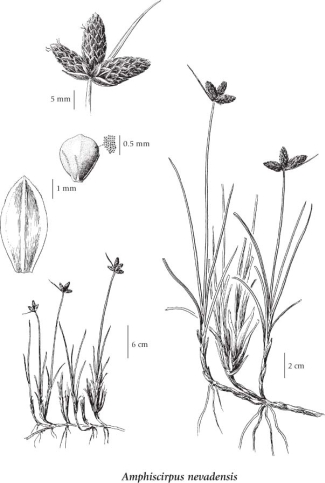Click on the image below to view an
expanded illustration for this species.

|
General:
Perennial herb from rhizomes; stems scattered or in small tufts, circular in cross-section, tapered, tough and wiry, emergent for most of their length when growing in water, 10-40 cm tall.
Leaves:
Several, clustered near the base; sheaths persistent; blades firm, deeply grooved to thick and flat, mostly 1-2 mm wide, up to 20 cm long, often much shorter, the lowest ones sometimes reduced to scales.
Flowers:
Spikes (1) 2 to 10, terminal, 1-2 cm long, in compact, unstalked clusters; involucral bracts several, one or more of them short, reddish-tinged, resembling enlarged scales, the principal, longest ones slender, stiff, green, leaflike, 1.5-7 cm long, more or less spreading, sometimes resembling extensions of the stems, but more often diverging at an angle.
Fruits:
Scales numerous, shining brown, largely translucent except for the paler, firm midribs, which may be exserted beyond the scales into short, sharp, slender points, not notched at the tips; perianth bristles 1 to 3 (4), slender and much reduced, finely-barbed backwards, rarely surpassing the middle of the achenes, generally unequal; styles abruptly deciduous; achenes plano-convex, pale, firm-walled, about 2 mm long, the tips not sharp-pointed.
Notes:
The Eastham (1947) collection from the Fraser River delta was probably an introduction on sand dredgings.
Source: The Illustrated Flora of British Columbia
|
